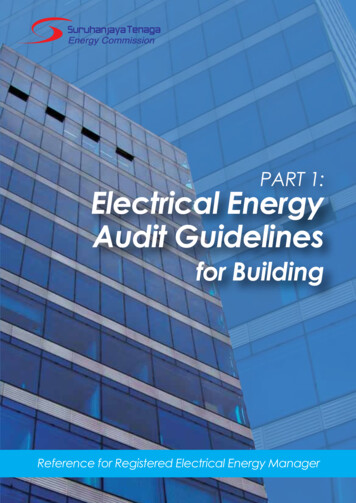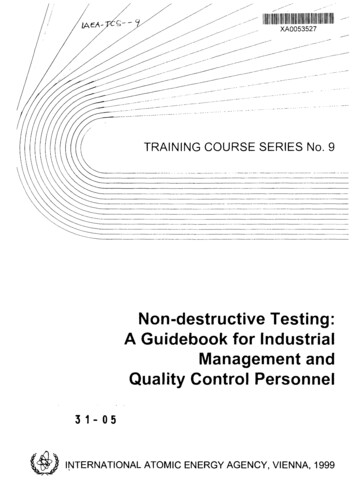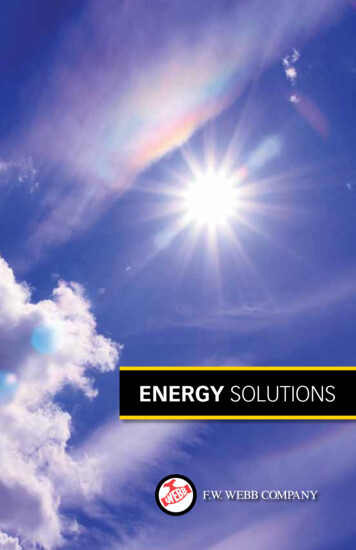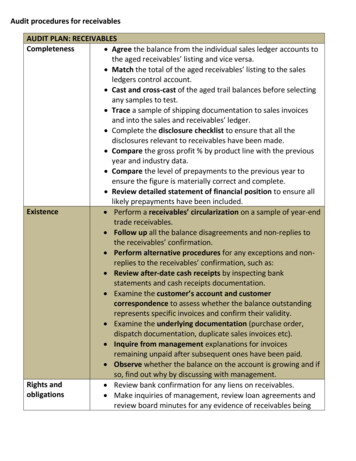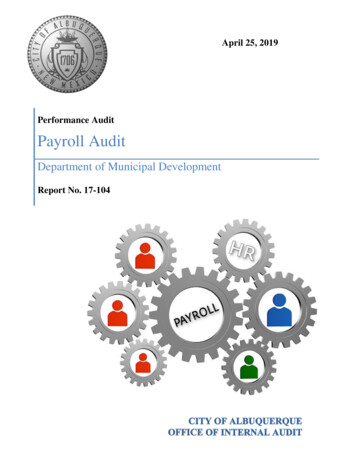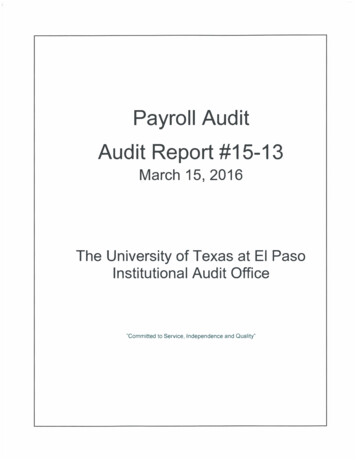
Transcription
LBNL-3991EERNEST ORLANDO LAWRENCEBERKELEY NATIONAL LABORATORYIndustrial Energy Audit Guidebook:Guidelines for Conducting anEnergy Audit in Industrial FacilitiesAli Hasanbeigi, Lynn PriceChina Energy GroupEnergy Analysis DepartmentEnvironmental Energy Technologies DivisionOctober 2010This work was supported by the China Sustainable Energy Program of the Energy Foundationthrough the U.S. Department of Energy under Contract No. DE-AC02-05CH11231. The U.S.Government retains, and the publisher, by accepting the article for publication, acknowledges,that the U.S. Government retains a non-exclusive, paid-up, irrevocable, world-wide license topublish or reproduce the published form of this manuscript, or allow others to do so, for U.S.Government purposes.
DisclaimerThis document was prepared as an account of work sponsored by the United StatesGovernment. While this document is believed to contain correct information, neither theUnited States Government nor any agency thereof, nor The Regents of the University ofCalifornia, nor any of their employees, makes any warranty, express or implied, or assumesany legal responsibility for the accuracy, completeness, or usefulness of any information,apparatus, product, or process disclosed, or represents that its use would not infringeprivately owned rights. Reference herein to any specific commercial product, process, orservice by its trade name, trademark, manufacturer, or otherwise, does not necessarilyconstitute or imply its endorsement, recommendation, or favoring by the United StatesGovernment or any agency thereof, or The Regents of the University of California. The viewsand opinions of authors expressed herein do not necessarily state or reflect those of theUnited States Government or any agency thereof, or The Regents of the University ofCalifornia.Ernest Orlando Lawrence Berkeley National Laboratory is an equal opportunity employer.i
Industrial Energy Audit Guidebook:Guidelines for Conducting an Energy Audit in Industrial FacilitiesAli Hasanbeigi, Lynn PriceChina Energy GroupEnergy Analysis DepartmentEnvironmental Energy Technologies DivisionAbstractVarious studies in different countries have shown that significant energy-efficiencyimprovement opportunities exist in the industrial sector, many of which are cost-effective.These energy-efficiency options include both cross-cutting as well as sector-specific measures.However, industrial plants are not always aware of energy-efficiency improvement potentials.Conducting an energy audit is one of the first steps in identifying these potentials. Even so,many plants do not have the capacity to conduct an effective energy audit. In some countries,government policies and programs aim to assist industry to improve competitiveness throughincreased energy efficiency. However, usually only limited technical and financial resources forimproving energy efficiency are available, especially for small and medium-sized enterprises.Information on energy auditing and practices should, therefore, be prepared and disseminatedto industrial plants.This guidebook provides guidelines for energy auditors regarding the key elements forpreparing for an energy audit, conducting an inventory and measuring energy use, analyzingenergy bills, benchmarking, analyzing energy use patterns, identifying energy-efficiencyopportunities, conducting cost-benefit analysis, preparing energy audit reports, andundertaking post-audit activities. The purpose of this guidebook is to assist energy auditors andengineers in the plant to conduct a well-structured and effective energy audit.ii
Table of Contents1. Introduction to industrial energy auditing . 11.1. Definition of energy auditing . 21.2. Objectives . 21.3. Types of energy audits . 21.4. Overview of energy audit procedures . 32. Preparation for the energy audit . 52.1. Defining the audit criteria . 52.2. Defining the audit scope . 52.3. Selection of energy audit team. 52.4. Making an audit plan . 62.5. Preparing an audit checklist. 62.6. Conducting the initial walk-through visit. 62.7. Collecting energy bills and available data and information . 72.8. Conducting the preliminary analysis . 73. Analyzing energy bills. 93.1. Electricity bills . 93.2. Natural gas bills . 103.3. Coal and fuel oil bills . 103.4. Graphical analysis of historical energy use . 114. Inventory and measurement of energy use . 134.1. Electrical load inventory . 134.2. Thermal energy use inventory . 134.3. Energy system-specific measurements . 144.4. Energy balance . 155. Analyzing energy use and production patterns . 165.1. Load/Demand profile . 165.2. Scatter diagram for presenting the dynamics of the energy-production relationship . 185.3. Interpretation of energy-production data pattern on a scatter diagram . 196. Benchmarking and comparative energy performance analysis . 217. Identifying energy efficiency and energy cost reduction opportunities . 23iii
7.1. Electrical demand control . 237.2. Cross-cutting energy-efficiency improvement options . 247.2.1. Energy-efficiency improvement opportunities in electric motors. 247.2.2. Energy-efficiency improvement opportunities in compressed air systems . 277.2.3. Energy-efficiency improvement opportunities in pumping systems . 307.2.4. Energy-efficiency improvement opportunities in fan systems . 347.2.5. Energy-efficiency improvement opportunities in lighting system . 357.2.6. Energy-efficiency improvement opportunities in steam systems . 377.2.7. Energy-efficiency improvement opportunities in process heating systems . 427.3. Sector-specific energy-efficiency improvement opportunities for selected industrialsectors . 438. Cost-benefit analysis of energy-efficiency opportunities . 458.1. Life-cycle cost analysis (LCCA). 458.2. Life cycle cost (LCC) method . 458.3. Net present value (NPV) method. 488.4. Internal rate of return (IRR) method . 498.5. Simple payback period (SPP) method . 509. Preparing an energy audit report . 5110. Post-audit activities. 5310.1. Create an action plan for the implementation of energy-efficiency measures . 5310.2. Implement the action plan . 54Acknowledgments. 56Acronyms . 57References . 58Appendixes. 66Appendix 1. Conversion factors . 66Appendix 2. Energy audit instruments . 67A.2.1. Safety considerations . 67A.2.2. Measuring electrical parameters. 67A.2.3. Temperature measurement . 68A.2.4. Flow measurements . 69A.2.5. Exhaust gas measurements . 69A.2.6. Measurement of the speed of rotating equipment . 70Appendix 3. List of sector-specific energy-efficiency improvement opportunities for selectedindustrial sectors. 71A.3.1. Cement industry . 71iv
A.3.2. Iron and steel industry . 73A.3.3. Textile industry. 76A.3.4. Petrochemical industry . 82A.3.5. Glass industry . 83A.3.6. Vehicle assembly industry . 84A.3.7. Fruit and vegetable processing industry . 85v
Industrial Energy Audit Guidebook:Guidelines for Conducting an Energy Audit in Industrial FacilitiesAli Hasanbeigi, Lynn PriceChina Energy Group, Energy Analysis DepartmentEnvironmental Energy Technologies DivisionLawrence Berkeley National LaboratoryEnergy audits assist industrial companies or facilities in understanding how they use energy andhelp to identify the areas where waste occurs and where opportunities for improvement exist.This guidebook provides step-by-step guidelines that can be easily followed even by those whohave not previously conducted energy audits. These guidelines are developed in a manner thatcan be used by both in-house auditors who are auditing their own plant and outsideconsultants who are hired to do an energy audit.The Canadian Industry Program for Energy Conservation (CIPEC) has published a guidebooktitled Energy Efficiency Planning and Management Guide (CIPEC 2002) which presents acomprehensive discussion of the procedures for conducting an industrial energy audit. CIPECalso has a more recent guidebook specifically for energy auditing called the Energy SavingsToolbox – an Energy Audit Manual and Tool (CIPEC 2009). These two CIPEC guidebooks are twoof the main references for Sections 1. to 4 of the guidelines presented here.Also, American Society of Mechanical Engineers (ASME) has published energy assessmentstandards that cover the assessment of
preparing for an energy audit, conducting an inventory and measuring energy use, analyzing energy bills, benchmarking, analyzing energy use patterns, identifying energy-efficiency opportunities, conducting costbenefit analysis, preparing energy audit reports, and - undertaking postaudit activities. The purpose - of this guidebook is to assist energy auditors and
